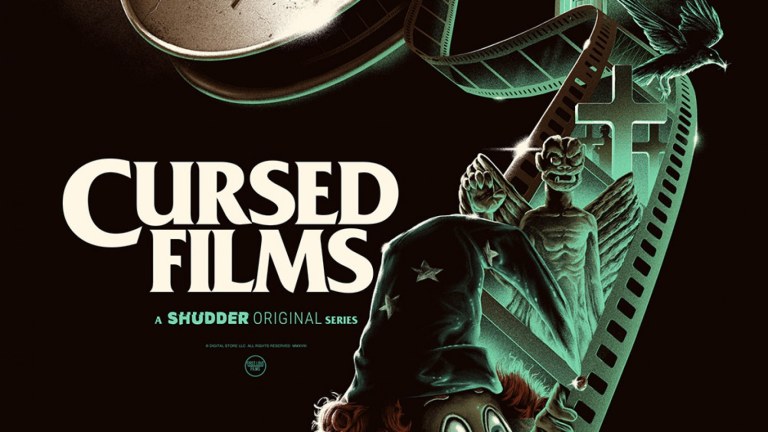How Shudder’s Cursed Films Explores the Most Troubled Horror Movies Ever
Filmmaker Jay Cheel takes us through his more balanced exploration of the cursed legacies surrounding The Exorcist, Poltergeist, The Omen, and more....

Some movies are born bad. Poltergeist, The Omen, The Exorcist; these are iconic horror films with reputations of misfortune and mishap. Either due to a series of grim coincidences that form a pattern or one or two notable tragedies, a handful of films are said to have near-evil legacies. Maybe it really is as Shirley Jackson mused in The Haunting of Hill House? If some spots attach to themselves an atmosphere of goodness, “It might not then be too fanciful to say some houses are born bad.” So why not movies too?
Within horror films, curses are caused by the bite of a werewolf or a boy who willfully passes along a demonic STD, or a shamed elderly woman who utters an incantation over the button she’s torn from someone. Perhaps it is not a leap then that the production behind a movie about Satan’s offspring would likewise attract bad juju and itself become an entry of paranormal pop culture.
These are the ideas behind Cursed Films, Shudder’s original five-part documentary series helmed by filmmaker Jay Cheel, which premieres today on the streaming service. In addition to the three aforementioned films, the series also explores the supposed curses behind The Crow and Twilight Zone: The Movie.
But rather than repeat well-tread territory exhaustively covered by every entertainment outlet, Cheel, also a dedicated horror fan, goes deeper with Cursed Films. It is a fun–and sometimes heartbreaking–rumination on belief itself, as well as an examination of the filmmaking industry.
Along with religious studies experts, authors, alleged exorcists, apparent witches, and a self-professed Black Magic practitioner (and YouTuber), he speaks with those involved directly with the films, such as The Omen director Richard Donner and The Exorcist’s Linda Blair. In a particularly powerful interview about the supposed Poltergeist curse, special effects make-up artist Craig Reardon addresses the use of real human skeletons in the production–and the decades of offensive insinuations leveled at him.
Cheel joined me by phone to discuss Cursed Films, and in the interview below, he shares his approach to the series that distinguishes it from lore and rumor surrounding these movies.
What was your first cursed film as a kid?
It definitely would’ve been Poltergeist. That was a film on heavy rotation in my household. My mom loves that movie and was weirdly obsessed with it. Watching it as a kid, and hearing about the death of Heather O’Rourke was a powerful thing. [O’Rourke died at age 12 during filming of Poltergeist III due to complications from an undetected bowel obstruction.]
But I think one of my earliest memories is seeing Twilight Zone: The Movie at our local drive in. I would have been like three-years-old. I still remember that opening framing device of Albert Brooks and Dan Aykroyd driving in the car, and Aykroyd asking Albert Brooks if he wants to see something scary. Then he turns around with that crazy demon animal face. That is an image that has stuck with me ever since then. And funny enough, in the Poltergeist episode I interview Craig Reardon, and he was the special makeup effects artist who did that makeup. So we kind of came full circle.
What was the initial mission examining these films, considering the stories were well-known before the internet and now they are the stuff of countless listicles?
My take on this subject is to lean into it from the rational perspective and skeptical perspective, but without debunking anything. It’s not necessarily a show that sets out to debunk these curse legends, but we kind of use the stories as an opportunity to discuss bigger subjects. Like why are we so fascinated by these curse legends and how do horror films open us up to that sort of supernatural thinking? But yeah, these stories have been around for a long time, and you can Google these stories and find tons of internet listicles detailing a lot of things that happened on the sets of these films.
There is a fresh perspective on display that focuses on the human element of the legends and shows empathy to those involved.
I think that came from choosing a cast of subjects that would speak from a point of honesty. That allowed us to talk about these stories in a way that I don’t think has been done previously. You know when you think about the E! True Hollywood Story, and those variations of these tales, it’s more leaning into the supernatural side of things. I just wanted to provide some balance to that.
In addition to conducting interviews with people directly involved with the films, you take these detours to record exorcisms and film a Black Magician who places a curse on an unnamed film. What was the motivation behind that?
You can only go so far with the legend concept on its own. There are so many of these secondhand stories that have been passed along by professional storytellers. And I was never interested in this idea of doing an investigation into the truths behind some of these legends.
But all of these stories are connected to horror films and that’s not a coincidence. So I wanted to use that as an opportunity to talk about these bigger concepts–and actually get into some horror cinema history as well. We go into interesting places that I don’t think any of the previous articles or shows have really covered when it comes to this material.
Humans notice patterns and apply significance to them, and that’s where we start noticing these “curses.” From your approach as a storyteller, how many things have to happen in order to get that cursed label?
The more incidents attached to a film, the more power the story has… These stories have the lifespan they do because of the number of things that happen. Currently, I’m seeing reports of other supposedly cursed films. Nowadays it comes down to just sort of delays and scheduling issues The New Mutants and the Uncharted movie, because they’re just continually pushed back.
That’s obviously a different framing of what people might consider a curse. But with Twilight Zone, that movie is a film always listed amongst cursed movies because of one major incident. [During a segment directed by John Landis, an on-set accident involving a helicopter and pyrotechnics killed actor Vic Morrow and child actors Myca Dinh Le and Renee Shin-Yi Chen]. That incident was just so powerful it added this movie to those lists, even though it’s so clearly just a horrible tragedy.
Is there a deliberate arc to the series? You begin with The Exorcist and then Poltergeist, which both involve misfortune outside the set. But you conclude with The Crow and Twilight Zone, which had tragedy occur on-set.
That’s the arc our series takes. All of them have tragedies attached to them, but we start off with some of the ones that people might be most familiar with. As we move through the series, it gets a little more real when we start dealing with these incidents that are clearly a result of a lack of coordination on-set or a lack of consideration for the safety of others. It starts to reframe the idea of a curse. When you get to the Twilight Zone episode, it’s almost less about whether the film is cursed and more about the idea of the people who were involved in the making of that film, being cursed with having to live with what they experienced on that night.
It has become commonplace for reports of weird occurrences, hauntings, or curses to emerge on the publicity tour for certain types of scary movies. In your experience, do the people involved with these Cursed Films view the curse legends as beneficial for promotion or as having negative connotations?
Overall the feeling was, for the most part, they understood why people were fascinated by it, but didn’t like the label–especially when talking to someone like Craig Reardon who is very blunt about his distaste for this idea of films being cursed, and director Gary Sherman who was hounded by the tabloid press after the death of Heather in the making of Poltergeist III.
I think really the only examples of it being spun into a positive thing was during the production of The Omen. Richard Donner and Mace Neufeld, in our series, frame it as them feeling the film was blessed in a way, because it did so well at the box office, and I know that they did lean into a lot of those cursed legends.
As did The Exorcist.
They used a lot of that as PR. The Omen did have a tragedy connected to it, but it was after the production, and it was more about a lot of really unusual coincidences. With The Exorcist, a lot of the deaths were related to people who were dying of natural causes or older people. It doesn’t necessarily suggest anything supernatural or nefarious.
If this goes into a second season, are there other films that you like to investigate?
The challenge was we wanted to keep it horror focused, of course because it’s for Shudder. But at one point, we were including a film called Stalker, the [Andrei] Tarkovsky film, which is definitely not horror. If anything, it’s more science fiction. It’s an art house film that maybe not everyone might be familiar with, but it has an interesting cursed legend connected to it as well.
We actually filmed three interviews connected to that story. At one point, I had a version of that loosely cut, but we dropped that story just because it felt like it didn’t really fit in. That would be something I wouldn’t mind picking up on. There was just a lot of interesting material that we managed to shoot for that.
